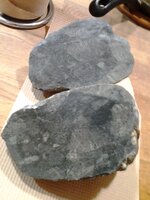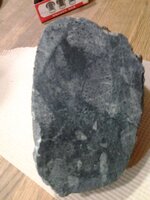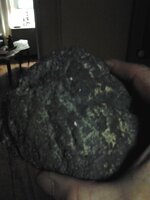TJE
Bronze Member


 This stone I discovered on The Bruce Peninsula (between Lake Huron and Georgian Bay). It was in the wash-out of a natural freshwater spring. Heavy for its size, After cleaning I noticed 3 little silvery protrusions. When magnified they're smooth but look melted (wavy)? After a search on the web the only pics of raw minerals that match is platinum.
This stone I discovered on The Bruce Peninsula (between Lake Huron and Georgian Bay). It was in the wash-out of a natural freshwater spring. Heavy for its size, After cleaning I noticed 3 little silvery protrusions. When magnified they're smooth but look melted (wavy)? After a search on the web the only pics of raw minerals that match is platinum.As for the interior..I halved the stone, then dampened the cut sides. Anyone have any idea?
Sorry about the close-up pics, I've not a proper camera. :/
















